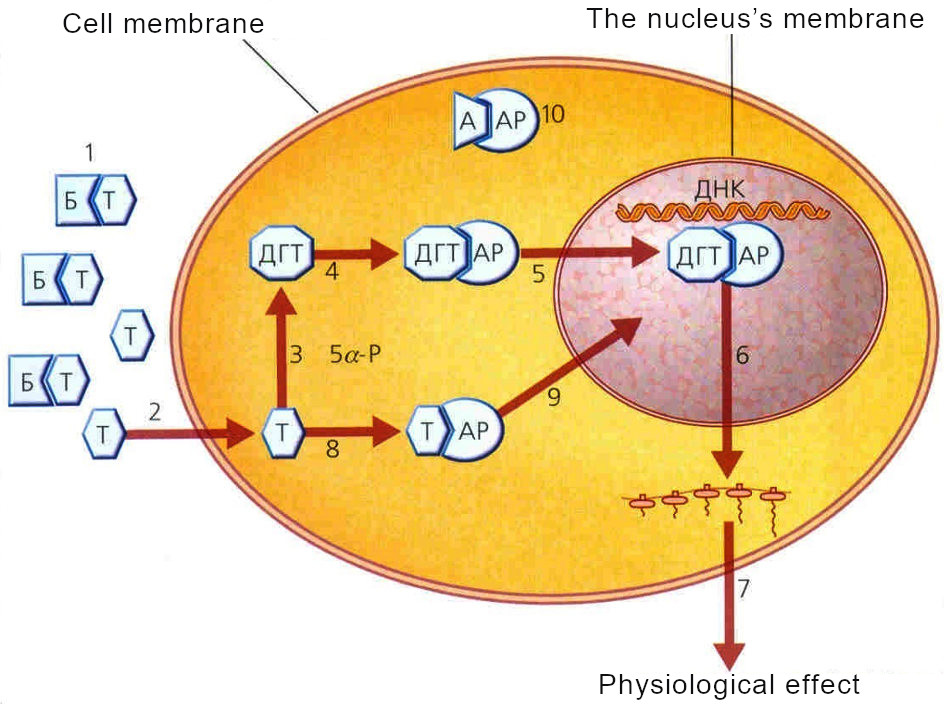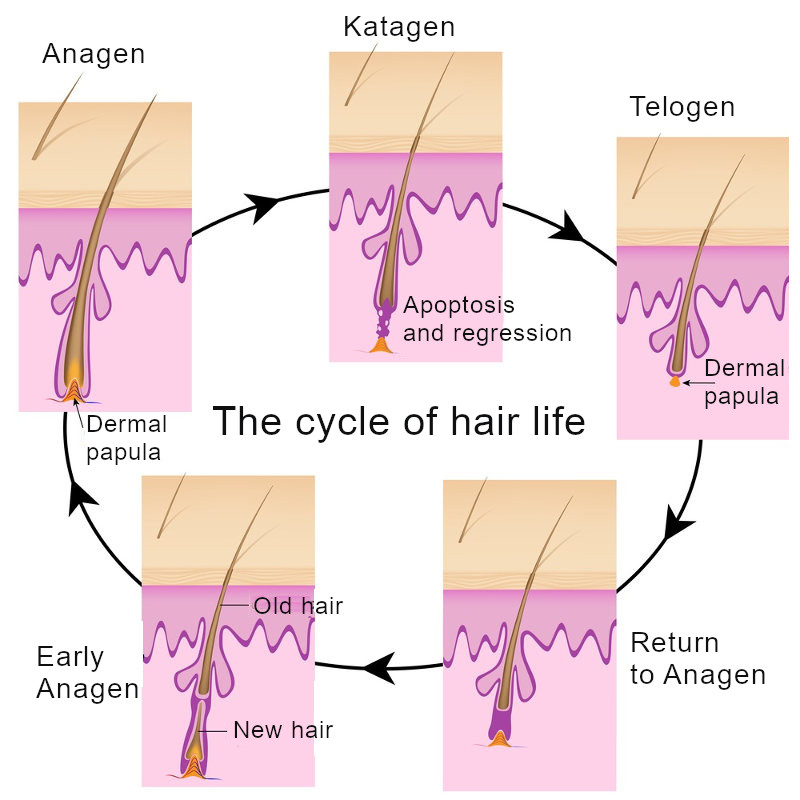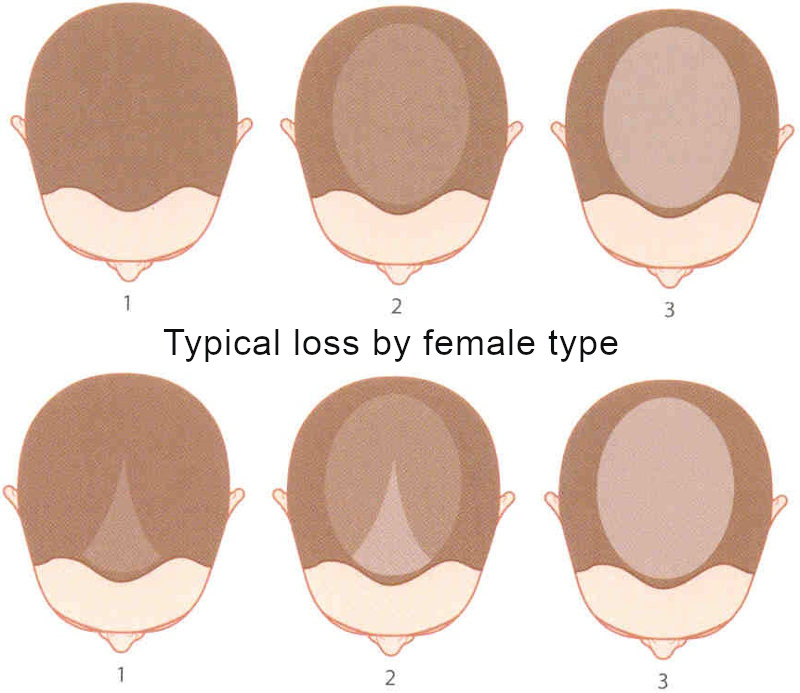HAIR: Why do we loose it? And how to get it back?
Causes of Alopecia
Since in the case of androgenetic alopecia the phases of the hair growth cycle are violated, in theory it is still believed that they can be corrected, but, unfortunately, often baldness does not respond to treatment due to the inflammatory process around the follicles damaging the follicular stem cells. In a situation where a significant loss of hair is not accompanied by a diffuse form of baldness, and even more so if it is not a priority form of baldness, the specialists of the clinic Volosy.ru can recommend patients the transplantation of their own hair.
Baldness is most often associated with the activity of the hormone - androgen dihydrotestosterone (DHT) and the increased sensitivity of the follicle - human hair follicle receptor, and since this is a genetic malfunction, the process of degeneration of the scalp scalp is called androgenetic alopecia (Androgenetic Alopecia, or AHA). AHA is equally affected by both men and women (typical male hair loss and typical female hair loss).

The main stages of androgen metabolism
1. Testosterone binds to circulating proteins. 2. Testosterone enters the cell nucleus. 3. Under the influence of 5α reductaza testosterone is converted to DHT. 4. DHT binds to the intracellular androgen receptor. 5. Complex DHT-receptor penetrates into the nucleus of the cell. 6. Complex DHT-receptor binds to DNA, which leads to the synthesis of cell-specific mRNA. 7. By the synthesis of proteins, a physiological effect occurs. 8. Direct binding of testosterone to another intracellular receptor. 9.The testosterone-receptor complex penetrates into the nucleus of the cell. 10.Antiandrogen binds to the intracellular androgen receptor. Abbreviations: Т - testosterone; Б - protein; Б-Т - a complex of protein-testosterone; АР - androgen receptor; ДГТ-АР - complex DHT-receptor; Т-АР - testosterone-receptor complex; АА - antiandrogen; АА-АР - antiandrogen receptor complexThe first signs of excessive hair loss can be manifested as early as fifteen or sixteen years, typically at the age of 19-20, and this process with varying degrees of activity makes itself felt up to forty years, and to fifty in half the cases becomes pronounced, conspicuous and others, and of course, the most balding.


An important role in the arsenal of combating androgenetic alopecia is played by hair growth stimulators, the most effective of which is minoxidil, and of course, antiandrogens - preparations for men containing finasteride, and synthetic OK with gestagens, intended for women. However, the most radical and effective remedy against androgenetic alopecia, the manifestations of which are dictated by genetically determined hereditary factors, is the transplantation of one's own hair.



It's no secret that baldness can also be triggered by taking a number of medications (carefully read the annotation to the medicines you take!), Chemotherapy, life-threatening radiation, chemicals, thyroid disorders, hormonal processes, malaise and nervous overexertion, local or general skin diseases. Among them, for example, diffuse alopecia and alopecia areata, which are based on not always understandable autoimmune processes; or scarred alopecia, when hair loss is formed due to skin diseases, scales, plaques, acne.



In this case scar alopecia is the result of a number of infectious diseases, such as herpes, syphilis, tuberculosis, AIDS; and autoimmune (lupus), microbial and fungal skin diseases, as well as radiation therapy, thermal and chemical scalp burns and simply scalp injuries. Important specification: in the case of post-traumatic scars, transplantation is the only way to restore the hairline, and as practice shows, it guarantees a significant improvement in the appearance of the damaged area of the skin, up to an ideal result with a lifelong guarantee! (See "Transplantation into the scar tissue").
Scientists have calculated that the human body has been "charged" with about five million hair follicles, or follicles since birth. They are most in blondes, in the second place - brunettes, least of all follicles in the scalp in people with red hair color. The follicle is an anatomical structure from which the stem of the hair, consisting of a protein called keratin, develops.
The life cycle of the hair comprises three phases: anagen - the period of active growth, catagen - gradual degradation, telogen - rest. The growth phase lasts from two to eight years, then within two to four weeks the hair bulb almost completely degrades, and there comes a rest period lasting usually two to four months.
Each person a day will drop about 50-100 hair, which at the end of the rest phase again begin to grow. Thus, 10-12% of the scalp follicles are always in the "sleeping" mode of telogen. If this percentage is relatively constant, the hairstyle retains the habitual density, the hair is beautiful and healthy.

Meanwhile, the follicles are composed of androgen receptors. During puberty, the genes that reduce the anagen - the growth phase - become so activated that the hair bulbs (follicles) that are in the androgen dependent region of the scalp interacting with the androgens are miniaturized. Each subsequent cycle of anagen becomes shorter than the previous one, the percentage of hair in the growth phase decreases, gradually they become thinner and shorter. Terminal hair is deprived of pigment, degradation processes gain strength, forming a sparse section of the scalp, and then the bald spot, covered with rare, barely noticeable hairs, which cease to grow and eventually die.

Note that the process of growth of axillary and pubic hair is dependent on testosterone, beard growth and androgenic alopecia are linked, in turn, dihydrotestosterone. The fact that testosterone (male sex hormone) is converted to dihydrotestosterone (DHT) by the enzyme - 5-alpha reductase three types. In the cells of the follicle membranes, there are receptors that are bound by androgens. When the receptor is already bound, dihydrotestosterone penetrates into the cell and begins to interact with the kernel, modifying a DNA molecule of protein production. Thus, the growth of the hair follicle slows down, and then completely ceases.
There is an opinion that the gene for alopecia is transmitted exclusively through the female line, which is not entirely true. On the maternal X chromosome is inherited information about 70-percent of the cases and, therefore, with a 30 percent chance of baldness can be inherited from the father. Moment when androgenetic alopecia is the first time will have an effect, as well as the pace of development of this process, and the final degree of baldness - all predict quite difficult, but in any case, trichologists doctors advise to more closely examine the situation with hair loss at the next of kin both maternal, and paternal.
But with all evidence it can be argued that with age, the problem will become increasingly obvious. The degree of alopecia often turns out to be the more significant the earlier it was manifested. Alopecia, which started in men, and sometimes in women under the age of twenty, is especially aggressive. However, the loss of hair can last for years and decades almost imperceptibly, so that it becomes visible when the forty or a little more than it turns out. Statistics state that androgenetic alopecia usually occurs in 20% of men over twenty years of age; 30% for thirty, 40% for forty ... And, of course, if the intense loss of hair that leads to baldness, once started, then it will necessarily continue according to the genome set by the AHA-script.
Dr. Hamilton, and later also Dr. Norwood, introduced a classification, and a scale of degrees of androgenetic alopecia was created.



Scientists have found that in the female body androgens, as well as in the male, stimulate baldness on a similar principle. However, in women who lose hair actively, the level of androgen circulation often does not exceed the average statistic, but the level of 5-alpha-reductase of the second type is often increased, which means that testosterone is converted to dihydrotestosterone, which affects the sensitive follicles. In addition, in some women too many androgen receptors are fixed, as well as a lower level of cytochrome P450, which converts testosterone to estrogen. All this is not for the benefit of thick female hair!
Some of the androgens in women are produced by the ovaries and adrenals. Ovaries produce and rudimentary hormones that are converted into androgens already outside the ovaries and adrenal glands. For all this, women usually do not lose their hair completely, and when hair loss in rare cases is total, it can most likely be an autoimmune process that is not directly related to androgenetic alopecia.
Unlike men, miniaturization of follicles in women is more chaotic. Hair partially intact, interspersed with degrading short, thinned, prone to loss. The line of hair growth in the region of the temples is less susceptible to degradation than is usual in men. The front line can be preserved, but significantly thinning, so it is especially striking. The area of alopecia mostly consists of damaged, thinned hair, often it is blurred throughout the scalp, which indicates a diffuse nature of the process of alopecia of the horizontal surface of the head. This type of sparsity of hair is not so common among men who usually have AGA-loss area, as a rule, concentrated on the front line and on the vertex. Hair in the anagen phase is gradually becoming smaller, and the abundance of "telogen" becomes "the norm". Ultimately, there comes a time when the radical reduction in the density of the hairdo hair decolorization becomes visually perceptible to everyone and everyone.
Dr. Ludwig introduced the now accepted worldwide gradation of the degrees of female alopecia, highlighting three main groups. Most often, patients undergoing increased hair loss, according to the Ludwig scale, are referred to the first type. The triggering mechanism for this process can be hormonal restructuring of the female body, associated, for example, with the use of contraceptives or with the postpartum period, as well as during and after menopause.

Usually in women suffering from androgenetic alopecia, menstrual regular, reproductive function is not violated, the endocrine system is normal. But if the menstrual cycle is irregular, and against this background, the process of hair loss is rapidly developing, acne has been tortured, it is necessary to check the endocrine system, to determine the level of prolactin, total testosterone, sulfate dehydroepiandrosterone.
Since in the case of androgenetic alopecia the phases of the hair growth cycle are violated, in theory it is still believed that they can be corrected, but, unfortunately, often baldness does not respond to treatment due to the inflammatory process around the follicles damaging the follicular stem cells. In a situation where a significant loss of hair is not accompanied by a diffuse form of baldness, and even more so if it is not a priority form of baldness, the specialists of the clinic Volosy.ru can recommend patients the transplantation of their own hair.